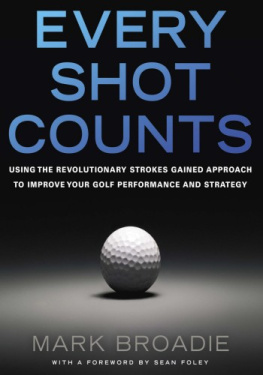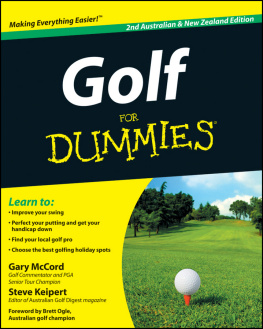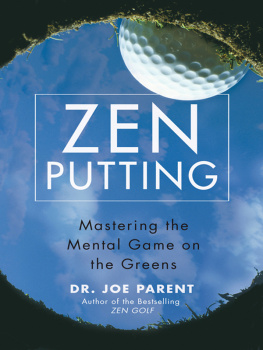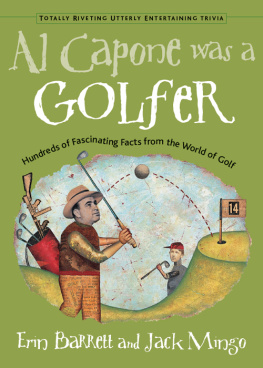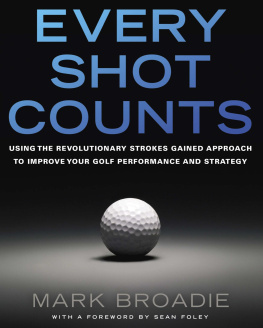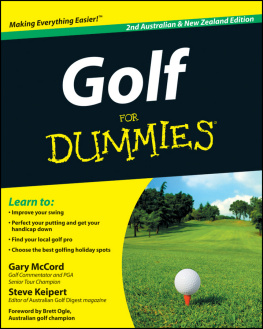Golf by the Numbers
GOLF by the Numbers
ROLAND MINTON

2012 The Johns Hopkins University Press
All rights reserved. Published 2012
Printed in the United States of America on acid-free paper
2 4 6 8 9 7 5 3 1
The Johns Hopkins University Press
2715 North Charles Street
Baltimore, Maryland 21218-4363
www.press.jhu.edu
ISBN-13: 978-1-4214-0315-1 (hardcover)
ISBN-10: 1-4214-0315-3 (hardcover)
Library of Congress Control Number: 2011929971
A catalog record for this book is available from the British Library.
Special discounts are available for bulk purchases of this book. For more information,
please contact Special Sales at 410-516-6936 or specialsales@press.jhu.edu.
The Johns Hopkins University Press uses environmentally friendly book materials, including recycled text paper that is composed of at least 30 percent post-consumer waste, whenever possible.
Contents
Preface
I was lucky enough to buy two great books in the 1980s. They may or may not make anybody elses list of enduring classics, and they certainly were not runaway best sellers in their time. Nevertheless, Peter Brancazios Sportscience: Physical Laws and Optimum Performance and The Bill James Baseball Abstract 1984 were inspirational. Without them, this book would not exist.
Brancazios Sportscience discusses a variety of physics concepts using sports. The extent to which it teaches physics through sports as opposed to explaining sports with physics is in the mind of the reader. It does both beautifully, and it opened up an exciting new world to me. Bill James is now well known to the sports public, often referred to as the father of the statistical analysis of baseball. the speaker discussed his use of the Abstracts to teach students how to analyze and write about statistical experiments.
Despite the large differences in subject matter, both books gave me a much-needed spark of inspiration. I have always been a sports fan but had not considered that this could benefit my career as a mathematics professor. Both Brancazio and James transferred to paper the essence of intellectual explorationa restless desire to fully understand important aspects of sports and a pure delight in their discoveries. I read their ideas and kept thinking, Of course, thats right. Why didnt I think of that? Thats great! The excitement of learning at the feet of two masters was invigorating.
and led directly to the opportunity to write this book. I hope that, in some measure, this book creates pleasure for you in the way that Brancazio and James did for me.
That you are holding this book right now means that you have overcome a powerful cultural bias against mathematics. This bias is a regrettable and, to my mind, inconceivable attitude for a country like the United States. If you get curious about something (anything!) and start to analyze it and understand it better, you are probably doing mathematics. Mathematics follows from trying to give unbiased answers to interesting questions. The precision required to remain unbiased can sometimes be daunting. In this book, Ive tried to minimize the daunt and keep the focus on the interesting questions.
An unfortunate truth of modern mathematics is that, contrary to algebra class where everything is solved exactly, simple answers are rare. This is especially true about the mathematics of golf. If you give me a golfers swing speed, can I tell you how far the drive will go? In a word, no. It depends on what ball is being used, the properties of the shaft and clubhead, the altitude and latitude of the course, and so on. Most of what you will find here are sample calculations intended to give you a slice of golf truth, and to improve your understanding and appreciation of the game (and, perhaps, mathematics).
Starting from the number of people for whom a book titled Golf by the Numbers might be purchased, there are enough equations in the book to reduce projected sales to one or less. My college library is required to buy a copy, so your purchase is an unexpected bonus. Thank you. More seriously, I have tried to segregate the mathematics to enhance the readability of the text. All overt calculus equations are in the endnotes.
The more technical arguments in each chapter are reserved for The Back Tee sections at the end of each chapter. On a golf course, playing from the back tees gives the greatest challenges and reveals the best the course has to offer. However, very enjoyable rounds can be had without venturing to the back tees. Similarly, the results in The Back Tee sections are interesting and accessible, but you can have an enjoyable read without facing every such challenge. My assumption is that you agree that equations are a convenient way to express precise relationships and are not a form of devil worship. I have used diagrams, graphs, and equations when I think that they help convey the information in a simpler and clearer form than the equivalent thousand words. If you so choose, you should be able to skip over the equations and find complete sentences that summarize the most important ideas to be gained from the equations.
Beyond standard high school mathematics, there is no specific mathematics course that I assume you have mastered. As in nearly every aspect of life, the more mathematics you know, the better. In my view, mathematics includes a variety of techniques for analyzing the world, so along with some equations you will see graphs, tables of numbers, logical arguments, and ideas from probability and statistics. It is all mathematics. If you are a person with a decent command of high school mathematics, a curiosity about how mathematics might be used to understand basic principles in golf, and some knowledge of golf as both player and fan, you are my ideal audience. However, even if you know little about golf, you will be able to follow along using the glossary to make sense of the arcane terms that are part of golf lingo.
As befits someone with Peter Brancazio and Bill James as muses, I have included a fair amount of physics and statistics in the book. However, I am neither a physicist nor a statistician. (My golfing buddies would be quick to jump in right now and tell you that Im not much of a golfer, either.) Instead, I am a mathematics professor who has always done work in applied areas, incorporating physics and statistics (and biology and economics and so on) as needed. The material in the book is sometimes reproduced (with proper credit) from other sources, sometimes adapted from other sources to suit my goals (again, with proper credit), and sometimes developed specifically for this book. (In some cases, I should admit, being a mathematician makes something deeply interesting to me that might not be terribly compelling to someone else.)
I have played golf most of my life. I learned to play at Hardys Driving Range and the numerous municipal courses in Dallas, especially Tenison Park. Unfortunately, I was born a couple of years too late to meet Hardys most famous employee, Lee Trevino. Where I sometimes accidentally slammed worm-burning drives into the 100-yard marker, Trevino had made considerable money hitting the marker intentionally with golf balls struck with Dr Pepper bottles. That is a polysyllabic way of saying that I taught myself. I benefitted greatly from the one lesson I had and envy young golfers today who have access to fantastic golf instruction and technology.
This book is not about finding the perfect swing. Golfers my age who grew up watching Arnold Palmer, Gary Player, Lee Trevino, Doug Sanders, Miller Barber, and others have a visual library that proves there are many ways to swing a golf club well. A man named Homer Kelley distilled years of intense experimentation into a complete description of the golf swing. He allowed for personal variations in many stages of the swing: more flexibility here, greater height here, extra weight there, and so on. Including variations, the perfect swing comes in 446,512,500,000,000,000 versions. (Unfortunately, the evidence shows that my swing is not one of them.)
Next page




